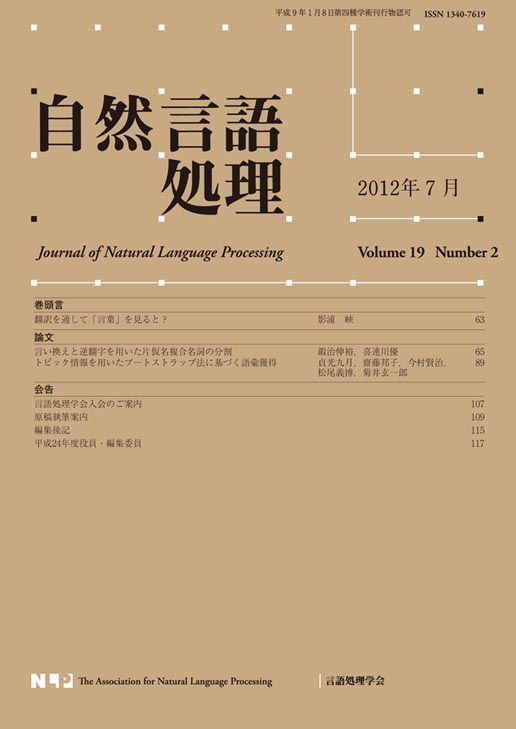All issues

Volume 18 (2011)
- Issue 4 Pages 321-
- Issue 3 Pages 215-
- Issue 2 Pages 69-
- Issue 1 Pages 1-
Volume 18, Issue 4
Displaying 1-4 of 4 articles from this issue
- |<
- <
- 1
- >
- >|
Preface
-
[in Japanese]2011 Volume 18 Issue 4 Pages 321-322
Published: 2011
Released on J-STAGE: December 28, 2011
JOURNAL FREE ACCESSDownload PDF (141K)
Paper
-
Yohei Kobashi, Tatsuro Sakano2011 Volume 18 Issue 4 Pages 323-350
Published: 2011
Released on J-STAGE: December 28, 2011
JOURNAL FREE ACCESSIn this paper, we examine Hierarchical Semantics for an annotation of a writer’s attitude toward a proposition in Japanese text. Hierarchical Semantics defines a universal semantic structure composed of a “proposition” and a “modality”. A modality is known as a linguistic concept of writer’s attitude and there are some linguistic modality theories which have been adopted in previous works. But the theories cover only grammatical forms because they are grammatical theories. On the other hand, Hierarchical Semantics defines modality not as syntax but semantics. The semantic definition is more useful to cover all of writer’s attitudes than the syntactic definition since there is hardly any excess formal condition. To confirm whether we can annotate the semantic information consistently, we examined the degree of consistency among Japanese native speakers’ annotations of truth, value and deontic judgments on Japanese newspaper editorials. The result shows that Fleiss’s kappa coefficients of truth, value and deontic judgments between them are 0.49, 0.28 and 0.70. The one of truth judgment can be increased to 0.58 by removing propositions which are inappropriate to ask the truth-value. In addition, these coefficients were 0.50, 0.28 and 0.53 even when we removed propositions which syntactically depend on a modal form or a subjective expression. It means that Japanese native speakers understand a writer’s attitude consistently even when it cannot be explained by lexcical or grammatical rules.View full abstractDownload PDF (617K) -
Masayuki Asahara2011 Volume 18 Issue 4 Pages 351-365
Published: 2011
Released on J-STAGE: December 28, 2011
JOURNAL FREE ACCESS
Supplementary materialThis paper argues about consistency of syntactic dependency corpus annotation. Dependency structure involves unambiguous substructures specified by syntactic constraints and underspecified substructures evaluated by selectional preferences of annotators. In most cases, the syntactic constraints have a priority over the selectional preferences. In some cases, however, the selectional preferences are given priority over the syntactic constraints. We propose a new psycholinguistic experimental environment to use a fitness game application, in which a user stands on Nintendo Wii Balance Board and plays a parsing game competing on the accuracy and the speed. Tha game-based experiments investigate how correctly a human can parse written sentences. We evaluate syntactically confusing sentences with 13 experimental subjects and 6 dependency parsers. Moreover, we investigate effects of selectional preferences in the incorrectly annotated sentences.View full abstractDownload PDF (630K) -
Shinsuke Mori, Yosuke Nakata, Graham Neubig, Tatsuya Kawahara2011 Volume 18 Issue 4 Pages 367-381
Published: 2011
Released on J-STAGE: December 28, 2011
JOURNAL FREE ACCESSThis paper proposes a pointwise approach to Japanese morphological analysis that decomposes the process into word segmentation and part-of-speech (POS) tagging. The pointwise approach refers, as features, only to the surface information of the input and not relies on any prediction results such as word boundaries or POS tags. This design allows us to use a variety of linguistic resources flexibly. This characteristic enables a fast and low-cost domain adaptation with a minimum amount of annotation. An evaluation was performed on a well-resourced general domain morphological task, and it was found that the proposed method achieved results comparable to those of existing methods such as CRFs and morpheme n-gram models. In addition, a domain adaptation experiment showed that the proposed method is able to achieve an effective domain adaptation with a smaller amount of annotations.View full abstractDownload PDF (801K)
- |<
- <
- 1
- >
- >|